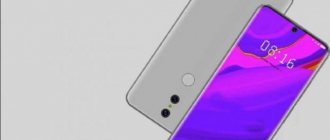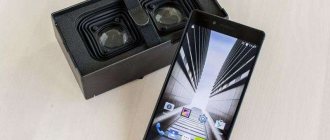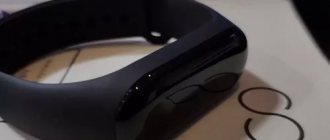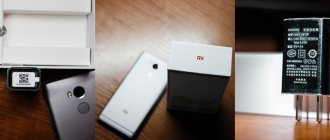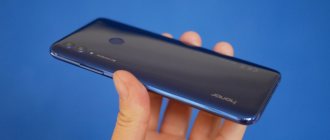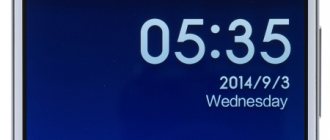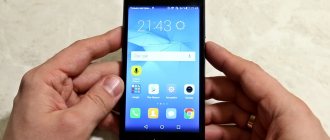We talked about the head of the new Xiaomi mid-segment line - Xiaomi A2, also known as Mi 6X. It turned out to be an excellent device!
It's time to study its simplified version Xiaomi A2 Lite . It is also available in 2 modifications, for the Chinese (Redmi 6 Pro) and European (A2 Lite) markets.
It seems that in the “up to 10 thousand” you won’t find anything more interesting: an IPS screen with FullHD, a dual camera, a capacious battery and all this in an “almost 4-inch” compact.
Design: iPhone X, metal and Xiaomi only
Redmi with a unibrow is something new.
The youngest in the Xiaomi “Google Phone” series has nothing in common with the older A2. It’s not surprising - their ancestors belong to different lines.
Xiaomi A2 Mi 6X in China , which became a successor to the ideas of Mi 5X, known as A1: a mid-price device, good quality and cheap. You could say it's balanced.
Xiaomi A2 Lite appeared through “Europeanization” from Redmi 6 Pro , which was never released on the international market.
“Eyebrow” and triple slot – an original combination
It is curious that in the Redmi series it is a “gray horse”: with Redmi 6 it is united only by the presence of a triple slot (2 x nanoSIM + microSD).
The brothers are made of plastic, and in it the engineers limited themselves to plastic inserts for the antennas. The metal body of the A2 Lite is much more similar to the regular Redmi fifth and fourth series.
The scanner works quickly and without errors
Good, tight assembly, the usual buttons and speaker/microphone grilles are in place. Everything is just like the good old times: even the minijack with the IR port is in place.
conclusions
Xiaomi Mia 2 Lite will appeal to owners for whom browsing the Internet, watching videos, communicating on social networks, reading e-books and making standard phone calls comes first.
If you need a high-end smartphone, you can pay attention to the older version of the Mi A2. Or on the budget Xiaomi - Redmi line with a limited budget.
In today's review, we discussed an affordable mobile device from Xiaomi, found out the main characteristics, customer opinions, pros and cons.
Screen: perfect IPS cheap
Perhaps the best screen in budget Android
The main difference between the A2 Lite and its predecessors is the unibrow . It is not available in other budget Xiaomi. But this is how the company was able to increase the screen diagonal while maintaining the dimensions.
According to them, A2 Lite corresponds to the classic Redmi, although the diagonal of its IPS matrix is 5.84 inches. Redmi 4 has 4.5, Redmi 5 has 5.7, Redmi 6 has 5.45.
The image remains clear even under bright lighting
In total, we have before us a budget COMPACT smartphone with an almost 6-inch diagonal with FullHD (versus HD in regular Redmi). This is cool!
There were some sacrifices: the screen frames are even larger than in Redmi 4X. With a unibrow he looks unique.
But only before turning it on. The screen is stunningly good: bright, rich, contrasting. And, most importantly, the fonts are displayed perfectly.
Oleophobic coating does not protect against glare
The only one of all Xiaomi budget phones that could boast such a diagonal was Redmi 4 Pro/Prime , which disappeared from Chinese shelves in 3-4 months (expensive for a budget phone, rather weak for the middle peasant).
Another advantage of the A2 Lite: there are no problems with adjusting the backlight level, as in classic Redmi on MIUI . Android One solves problems!
Video
Video recording capabilities are limited to 1080p 30 fps. Bitrate is 20 Mbit/s, sound 96 Kbit/s.
The video quality is very good. The detail is quite high, the dynamic range is average, colors and contrast are at a high level. The noise level is kept low. The sound didn't disappoint either.
There is video stabilization, which needs to be enabled in the settings. Due to stabilization, detail and field of view are slightly reduced. You won't see any stabilization in the viewfinder, but the end result won't disappoint.
The digital signal processor in the Snapdragon 625 supports 4K video recording. However, this smartphone does not have such an option. There was a suspicion that it was possible to shoot 4K video using third-party applications. Installing the OpenCamera program confirmed this, 4K 30fps is available. Even electronic image stabilization works, although at a lower level than in the main camera.
The shooting is done in MP4 format and the image is displayed very smoothly. The frame rate does not drop below 30 fps and 40 Mbps.
Android or MIUI? What to choose?
Maximum metal, minimum plastic
In fact, the Chinese Xiaomi Redmi 6 Pro and A2 Lite are the same smartphone.
But the first runs on MIUI, while the second is created with the support of Google and is part of the Android One program.
Compared to regular Android, and even more so to various Chinese products in the style of Huawei (EMUI) or Lenovo (EMU), the superiority of MIUI is obvious.
There are many differences between Android One. We'll look at it in a separate article.
But Android One uses special lightweight versions of Google services, has a modified system core and offers the simplest interface.
Perfect Android, fast and error-free. Thanks to her, the Xiaomi A2 Lite cannot be recognized as a budget phone.
Productive budget employee
Behind one grille is a microphone, behind the second is a speaker.
The smartphone's processor is an eight-core Qualcomm Snapdragon 625 . Not fast, but proven and highly optimized.
It is installed in many of the company’s devices: Mi Max 2, Redmi 4 Prime, Redmi 4 Note, Redmi S2/Y2 and even in the mid-priced Redmi 5 Plus and Mi 5X/A1.
The list is impressive. Should we be surprised by the choice? MIUI and Snap 625 are a great pair for every day.
The tray holds 2 nanoSIM and microSD cards up to 128 GB
FullHD was not a problem for the 2020 processor. You shouldn’t dream about PUBG Adreno 506 .
Performance is supported by 3 or 4 GB of RAM and 32/64 GB storage. Enough for a workhorse.
And if that’s not enough, the A2 has a triple tray, like the Redmi 6 : for a couple of SIM cards and microSD. There is no need to fence the sandwich.
Processors
The Mi A2 phablet received a powerful and modern Snapdragon 660 processor with eight Kryo 260 cores with a frequency of up to 2.2 GHz and an Adreno 512 graphics accelerator. Its capabilities are enough even for modern games, even if not with maximum graphics settings.
The Mi A2 Lite has the same chip as last year's Mi A1 and the more current Redmi 5 Plus - Snapdragon 625 with eight Cortex-A53 cores at 2 GHz and Adreno 506 graphics. This processor was an excellent solution for mid-range devices in 2020, when its announcement took place. However, now it is noticeably inferior to modern analogues. For comparison: the same Redmi 5 Plus scores about 77,000 points in AnTuTu 7, while the Mi A2 scores more than 130,000, which is confirmed by GSMArena tests.
What can a dual camera do in a smartphone for 10 thousand?
Dual module in a budget phone? For what?
The dual main camera (12 MP + 5 MP) has become another strong point of the Xiaomi A2 Lite. An additional module is used for light correction.
Strictly speaking, you don’t expect such pictures from a device that costs 10 thousand: juicy, bright, clear. In normal lighting.
The notification LED has moved downwards from the camera so as not to interfere
The front camera corresponds to the budget segment, there is nothing to blame. You can use it.
Darkness continues to be a problem for Xiaomi. On the other hand, Xiaomi A2 Lite takes better pictures than other budget phones.
In a separate article we will try to compare the capabilities of different Redmi.
Camera
The camera, which is very good in the regular Mi A2, is missing stars from the sky in the younger version. The smartphone has a dual 12+5 MP module with f/2.2 aperture. During the day, both devices delight with high-quality images and take pictures with approximately the same detail and color rendition. But when there is insufficient lighting, the low aperture of Light's optics makes itself felt, detail drops greatly, a lot of noise appears, and taking an unblurred picture becomes a real challenge.
Portrait mode works fine, but there are questions about HDR; it turned out to be useless, since it practically does not expand the dynamic range of the image. In general, installing a Google camera just suggests itself, but for this you will have to dance with a tambourine, since Camera API 2 in the smartphone is not activated by default.
The 5 MP front camera produces good results, but in the same Redmi S2 it is head and shoulders above. Selfies can be taken in portrait mode, and the background is blurred correctly in most cases.
Mi A2 Lite can record 1080p video with electronic stabilization. Video shooting, in general, is implemented well - the videos are smooth, with detail adequate for FHD and normal sound. When you install Google Camera, 4K shooting becomes available.
Autonomy: like Lenin, always alive
A2 Lite is the only Redmi 6 with normal battery life
Insane battery life - that's why they love Redmi! And the A2 Lite is fine with this.
The built-in battery has a capacity of 4000 mAh , which is enough to operate from 24 hours to 3 days, depending on the user’s activity.
Infrared port for equipment control and mini-jack for headphones
In “pure” scenarios, everything is very good: you can watch a video for 12 hours , play for at least 6 .
The only question for the developers is the lack of fast charging. An hour and a half at a power outlet today cannot be called a pleasant pastime.
Software
Both devices differ from their counterparts in the Xiaomi lineup in that they received “pure” Android 8.1. That is, you see the system as Google intended it to be. The advantage of this approach is that you are using the “correct” Android, this is a kind of standard system, which usually phone manufacturers supplement with bells and whistles to suit their taste.
In this case, Xiaomi uses the MIUI shell. It is convenient, fast, very functional, and, in my opinion, it is more interesting to buy Xiaomi with MIUI, but in many respects this is a matter of taste, so you may not agree with me.
Instead of conclusions: pay, there is a difference
Excellent mid-to-low segment smartphone
Compared to other sixth-generation Redmi, Xiaomi A2 Lite stands out for its improved appearance, more powerful hardware based on Quallcomm processors and a normal camera.
Xiaomi A2 Lite is not Redmi on MIUI, but a smartphone in the development and support of which Google participates.
Simplified Android One allows the smartphone to compete even with more powerful devices: it is faster, the system is smoother and more convenient. In addition, 2 years of updates . Serious request.
Next to the older A2 without the index, the A2 Lite stands out due to its small dimensions and greater autonomy.
The scanner is no worse than those in the best flagships
With a price of $169 for the 4/64 GB version and $137 for the younger 3/32 GB with coupon 4G4PefBQ can safely be called the best budget smartphone - or, at least, the best smartphone in the price category up to 10 thousand rubles.
Review of the Xiaomi Mi A2 Lite smartphone from the Android One program
In the new season, Xiaomi Mi A2 and Xiaomi Mi A2 Lite not only updated, but also expanded the company’s line of mobile devices, which started last year with a single model, Xiaomi Mi A1. This line is notable for the fact that the developer abandoned its own MIUI interface in favor of a “pure” Android OS. The release program for such models was developed jointly with Google, so all new products with the “Android One” logo (and similar smartphones are produced not only by Xiaomi, but also by some others, for example Nokia) will receive the latest updates earlier and longer than others, which for devices on Android is always a burning question. We have already described the older model of the updated series - Xiaomi Mi A2 - in the corresponding review, and today we turn our attention to the more affordable and simpler, but at the same time not devoid of zest, junior model Xiaomi Mi A2 Lite.
Main characteristics of Xiaomi Mi A2 Lite
- SoC Qualcomm Snapdragon 625, 8 cores Cortex-A53 @2.0 GHz
- GPU Adreno 506
- Operating system Android 8.1
- Touch display IPS 5.84″, 2280×1080 (19:9), 432 ppi
- Random access memory (RAM) 3/4 GB, internal memory 32/64 GB
- MicroSD support up to 256 GB
- Nano-SIM support (2 pcs.)
- GSM/WCDMA networks
- LTE networks FDD B1, 3, 4, 5, 7, 8, 20, TD B38, 40
- Wi-Fi 802.11a/b/g/n/ac (2.4 and 5 GHz)
- Bluetooth 4.2
- No NFC
- GPS, A-GPS, Glonass, BDS
- Micro-USB, USB OTG
- Audio output 3.5mm
- IR port
- Main camera 12 MP, f/2.2 + 5 MP, 1080p video
- Front camera 5 MP, f/2.0
- Proximity and lighting sensors, magnetic field, accelerometer, gyroscope
- Fingerprint's scanner
- Battery 4000 mAh
- Dimensions 149×72×8.8 mm
- Weight 178 g
| Average price of Xiaomi Mi A2 Lite (3/32 GB) | Average price of Xiaomi Mi A2 Lite (4/32 GB) | Average price of Xiaomi Mi A2 Lite (4/64 GB) |
| find out prices | find out prices | find out prices |
| Retail offers Xiaomi Mi A2 Lite (3/32 GB) | ||
| find out the price | ||
| Retail offers Xiaomi Mi A2 Lite (4/32 GB) | ||
| find out the price | ||
| Retail offers Xiaomi Mi A2 Lite (4/64 GB) | ||
| find out the price | ||
Appearance and ease of use
If we talk about general design features, the Xiaomi Mi A2 Lite looks simpler than the Xiaomi Mi A2 due to its plastic end inserts. And in general, the body of the Xiaomi Mi A2 Lite is rough, with wider sides, and a large number of clearly visible seams between parts reduces the appearance. Over time, dirt gets stuck in the seams, the smartphone looks clearly cheaper than Xiaomi Mi A2 or Xiaomi Redmi Note 6 Pro - however, it is really cheaper.
At the front, the younger device received an ugly cutout in the screen, although its older brother has nothing like that. To be fair, the cutout isn't the biggest (widest) we've seen.
But there is also a positive point: due to the greater thickness of the case and wider and flatter sides, the Xiaomi Mi A2 Lite is much stronger and more securely held in the hand. The thin and light Xiaomi Mi A2 with its pointed sides does not have enough grip area with the palm, it scrolls in the fingers. Here you find in your hand a kind of monolithic and weighty (and the Xiaomi Mi A2 Lite turned out to be even heavier than the Xiaomi Mi A2) block that does not slip out of your hand at all.
Considering that the matte surfaces of the Xiaomi Mi A2 Lite do not collect fingerprints, we can state that the device as a whole is more ergonomic and practical than the older Xiaomi Mi A2.
And one more pleasant point: since the body here is not so thin and light, and the camera does not protrude so much, the smartphone lies reliably and steadily, and does not sway like a paperweight on the table, like its older brother. He has real problems with this: Xiaomi Mi A2 jumps and spins on a hard surface.
The fingerprint scanner area on the back side is slightly recessed and is easy to touch. The scanner works clearly, without any complaints.
Another interesting difference between the two A2 models is hidden on the front panel. Here the LED event indicator was embedded not at the top, but at the bottom under the screen. The LED shines with a soft milky light directly from the bottom thin strip, this is quite unexpected, but does not cause dissatisfaction.
But, as you might guess, the front camera of the Xiaomi Mi A2 Lite, unlike the older Xiaomi Mi A2, did not receive its own flash, which is a pity. Moreover, this cutout in the screen for the sake of ridiculous fashion...
The side buttons are conveniently installed on one side; there are no buttons on the opposite side, which is nice. The keys themselves are large, the response is very clear, but a bit harsh, like the Xiaomi Mi A2.
The slot on the left side can accommodate two Nano-SIM cards and a microSD memory card at the same time. Hot swapping of cards is supported. In Xiaomi Mi A2, by the way, owners were deprived of the ability to install memory cards, but here everything is in place.
At the top end you can find not only a small hole for an auxiliary microphone, but also an IR port for emulating a remote control. One of the disappointments from the Xiaomi Mi A2 is the lack of a 3.5mm audio output for headphones. But here - nothing, they installed it, and the world did not collapse. It seems like two models of the same subfamily, but what differences there are: the headphone jack was left, and there was a place for a memory card in a smaller case, it’s simply amazing.
The main speaker is located at the bottom end, where the Micro-USB connector is also located. Again, there is an artificial separation of two related models: if the Xiaomi Mi A2 had a USB Type-C connector, then, of course, there should be Micro-USB.
Well, at least in the choice of colors, the Xiaomi Mi A2 and Xiaomi Mi A2 Lite have complete parity: the younger model is presented in the same three colors - black, gold and blue. The smartphone did not receive protection from dust and moisture.
Screen
Xiaomi Mi A2 Lite is equipped with an IPS display covered with 2.5D glass with sloping edges. The physical dimensions of the screen are 64x135 mm, diagonal - 5.84 inches. At the same time, the screen resolution is 2280x1080 with an aspect ratio of 19:9 and a pixel density of about 432 ppi. The frame around the screen is approximately 3.5 mm thick on the sides, 10 mm on the top, and 10 mm on the bottom. If you don’t take the cutout into account, then 4.5 mm remains at the top, but it cannot be ignored, that’s why it’s a cutout.
It is possible to use automatic brightness adjustment based on the operation of the ambient light sensor. With default settings, multi-touch tests diagnose support for 10 simultaneous touches.
A detailed examination using measuring instruments was carried out by the editor of the “Monitors” and “Projectors and TV” sections Alexey Kudryavtsev . Here is his expert opinion on the screen of the sample under study.
The front surface of the screen is made in the form of a glass plate with a mirror-smooth surface that is scratch-resistant. Judging by the reflection of objects, the anti-glare properties of the screen are no worse than those of the Google Nexus 7 (2013) screen (hereinafter simply Nexus 7). For clarity, here is a photo in which a white surface is reflected when the screens are turned off (on the left - Nexus 7, on the right - Xiaomi Mi A2 Lite, then they can be distinguished by size):
The screen of the Xiaomi Mi A2 Lite is slightly darker (brightness according to photographs is 113 versus 114 for the Nexus 7). The ghosting of reflected objects in the Xiaomi Mi A2 Lite screen is very weak, this indicates that there is no air gap between the layers of the screen (more specifically, between the outer glass and the surface of the LCD matrix) (OGS - One Glass Solution type screen). Due to the smaller number of boundaries (glass/air type) with very different refractive indices, such screens look better in conditions of intense external illumination, but their repair in the case of cracked external glass is much more expensive, since the entire screen has to be replaced. There is a special oleophobic (grease-repellent) coating on the outer surface of the screen (noticeably better in efficiency than that of the Nexus 7), so fingerprints are removed much more easily and appear at a slower rate than with regular glass.
When manually controlling the brightness and displaying the white field in full screen, the maximum brightness value was about 520 cd/m², the minimum was 2.2 cd/m². The maximum brightness is very high, and given the excellent anti-glare properties, screen readability even on a sunny day outdoors should be at a good level. In complete darkness, the brightness can be reduced to a comfortable value. There is automatic brightness adjustment based on the light sensor (it is located to the left of the front speaker slot). In automatic mode, as external lighting conditions change, the screen brightness both increases and decreases. The operation of this function depends on the position of the brightness adjustment slider. If it is 100%, then in complete darkness the auto-brightness function reduces the brightness to 110 cd/m² (too bright), in an office illuminated by artificial light (about 550 lux) it sets it to 330 cd/m² (it could have been lower), in in a very bright environment (corresponding to lighting on a clear day outdoors, but without direct sunlight - 20,000 lux or a little more), the brightness increases to 520 cd/m² (to the maximum, as needed); if the slider is about 50%, then the values are as follows: 4.3, 130 and 520 cd/m² (the first value is a bit low); if the regulator is at 0% - 2.2, 8 and 520 cd/m² (the first two values are already too low). We moved the slider to 65% and for the three conditions described above we got 15, 200 and 520 cd/m² (suitable values). It turns out that the auto-brightness function works adequately and allows the user to customize their work to individual requirements. At any brightness level, there is no significant backlight modulation, so there is no screen flicker.
This smartphone uses an IPS matrix. The microphotographs show a typical IPS subpixel structure:
For comparison, you can see the gallery of microphotographs of screens used in mobile technology.
The screen has good viewing angles without significant color shift even with large viewing deviations from perpendicular to the screen and without inverting shades. For comparison, here are photographs in which the same images are displayed on the screens of Xiaomi Mi A2 Lite and Nexus 7, while the screen brightness is initially set to approximately 200 cd/m², and the color balance on the camera is forced to switch to 6500 K.
There is a white field perpendicular to the screens:
Note the good uniformity of brightness and color tone of the white field.
And a test picture:
The colors on the screen of the Xiaomi Mi A2 Lite are slightly more saturated than natural (the skin is too reddish), the color balance of the Nexus 7 and the tested screen is slightly different.
Now at an angle of approximately 45 degrees to the plane and to the side of the screen:
It can be seen that the colors have not changed much on both screens, but on the Xiaomi Mi A2 Lite the contrast has decreased to a greater extent due to the strong brightening of black.
And a white field:
The brightness at an angle of the screens decreased (at least 5 times, based on the difference in shutter speed), and decreased approximately equally.
When deviated diagonally, the black field becomes very bright and acquires a reddish tint. The photographs below demonstrate this (the brightness of the white areas in the direction perpendicular to the plane of the screens is the same!):
And from another angle:
When viewed perpendicularly, the uniformity of the black field is very good:
The contrast (approximately in the center of the screen) is high - about 1270:1. The response time for the black-white-black transition is 20 ms (10 ms on + 10 ms off). The transition between halftones of gray 25% and 75% (based on the numerical value of the color) and back takes a total of 34 ms. The gamma curve, constructed using 32 points with equal intervals based on the numerical value of the shade of gray, did not reveal any blockage in either the highlights or the shadows. The exponent of the approximating power function is 2.25, which is slightly higher than the standard value of 2.2. In this case, the real gamma curve deviates little from the power-law dependence:
We did not detect the presence of dynamic adjustment of the backlight brightness in accordance with the nature of the displayed image, which is very good.
Color gamut is slightly wider than sRGB:
The spectra show that the matrix filters moderately mix the components with each other:
At the same time, the humps of green and red colors are relatively well separated, which leads to some broadening of the color gamut.
In the settings you can reduce the intensity of the blue component:
In principle, bright light can lead to disruption of the circadian rhythm (see the article about the iPad Pro with a 9.7-inch display), but everything can be solved by adjusting the brightness to a comfortable level, and there is absolutely no way to distort the color balance, reducing the contribution of blue sense. Unfortunately, this setting cannot be used to correct color balance, since even with minimal correction the color temperature is too low, it is equal to 4800 K.
The balance of shades on the gray scale is good, since the color temperature is not much higher than the standard 6500 K, and the deviation from the blackbody spectrum (ΔE) is below 10, which is considered a good indicator for a consumer device. At the same time, color temperature and ΔE change little from hue to hue - this has a positive effect on the visual assessment of color balance. (The darkest areas of the gray scale can be ignored, since color balance there is not very important, and the error in measuring color characteristics at low brightness is large.)
To summarize: the screen has a very high maximum brightness and has excellent anti-glare properties, so the device can be used outdoors even on a sunny summer day without any problems. In complete darkness, the brightness can be reduced to a comfortable level. It is also possible to use a mode with automatic brightness adjustment, which works adequately. Also, the advantages of the screen include the presence of an effective oleophobic coating, the absence of an air gap in the layers of the screen and visible flicker, good uniformity of the black field, high contrast and acceptable color balance. Significant disadvantages include the low stability of black to gaze deviation from perpendicular to the screen plane. Taking into account the importance of characteristics for this particular class of devices, the screen quality can be considered high.
Camera
The front camera of Xiaomi Mi A2 Lite has a 5 MP sensor resolution and a lens with an F2.0 aperture. There is no portrait mode as such, but there is a software background blur function, as well as retouching. The shooting quality is noticeably lower than that of the Xiaomi Mi A2, the resolution of the matrix is clearly not enough, indoor images are frankly “noisy”, and the detail is low outdoors. Why such a poor front module was installed here is unclear.
The main camera of Xiaomi Mi A2 Lite uses two modules. The main module has a 12 MP sensor resolution (Sony IMX486) and a lens with an f/2.2 aperture. There is also an auxiliary module with a resolution of 5 megapixels. There is no optical stabilization. Manual mode is simplified to two parameters: you can select white balance and light sensitivity. There is no standard option to save pictures in RAW.
Examples of pictures from the rear camera:
The quality of shooting with the main camera cannot be called high, but in good lighting it is acceptable. Discolored noise is visible even in daytime photographs, detail in the center of the frame is rather weak, and towards the edges of the frame it still falls, grass and foliage tend to merge into a blur. Night shots (and in general shots for which the device has to raise the light sensitivity level) are no good.
Video can be shot in 1080p format at 30 fps; there is no optical stabilization, but there is electronic stabilization. You cannot select the H.265 codec for video recording. The shooting quality is average: the detail is low, the image is loose. At night, the quality drops radically: detail deteriorates noticeably, noise is clearly visible, electronic stabilization fails, and the image “strobes.” But the sound, surprisingly, is recorded cleaner than that of the Xiaomi Mi A2, without distortion or echo.
- Video No. 1 (35 MB, 1920× [email protected] fps, H.264, AAC)
- Video No. 2 (24 MB, 1920× [email protected] fps, H.264, AAC)
- Video No. 3 (28 MB, 1920× [email protected] fps, H.264, AAC)
- Video No. 4 (23 MB, 1920× [email protected] fps, H.264, AAC)
- Video No. 5 (22 MB, 1920× [email protected] fps, H.264, AAC)
Telephone and communications
The X9 LTE modem, built into the Qualcomm Snapdragon 625 SoC, supports several LTE frequency bands (Category 7, up to 150/300 Mbit/s), including all three LTE FDD bands used in Russia (Band 3, 7, 20). In practice, within the city limits of the Moscow region, the device demonstrates reliable operation in wireless networks, does not lose connection, and quickly restores connection after a forced interruption.
The Wi-Fi module supports both bands (2.4 and 5 GHz), there is support for 802.11ac, but again there is no NFC module.
The navigation part of the smartphone is in perfect order. The receiver works with GPS (with A-GPS), and with the domestic Glonass, and the Chinese Beidou. The first satellites, even during a cold start, are detected quickly, within the first seconds, and the positioning accuracy does not cause any complaints. The magnetic compass required for navigation programs is in place.
The phone application supports Smart Dial, that is, while dialing a phone number, a search is immediately carried out by the first letters in contacts. Methods for setting up sorting and display of contacts are standard for the Android interface. The vibration alert is customizable, and in maximum mode its intensity is very high, there are no complaints. There is support for VoLTE.
The hardware platform allows the smartphone to support both SIM cards in 3G/4G mode at the same time. The cards operate in Dual SIM Dual Standby mode, there is only one radio modem.
Software and multimedia
As a software platform, Xiaomi Mi A2 Lite uses Android OS version 8.1 with the ability to update over the air (OTA). The Mi A2 and Mi A2 Lite smartphones continue the series started by Xiaomi with the Mi A1 model, which is released on pure Android OS without its own MIUI shell. The Android One program is carried out jointly with Google itself; such devices receive updates earlier than others and are supported longer.
The interface and settings are completely consistent with pure Android, no changes have been made here. There is a full set of Google Apps and a full Play Store. There was no FM radio or voice recorder in this model, but, in fact, the voice recorder is not included in the standard package of the “pure” Android OS. The smartphone sounds quite satisfactory for its level: the sound is loud and clear, not for music lovers, of course, but overall not bad.
Performance
Xiaomi Mi A2 Lite runs on Qualcomm Snapdragon 625 SoC. This 14nm SoC is configured with an octa-core processor containing ARM Cortex-A53 processor cores with a frequency of up to 2 GHz. The Adreno 506 GPU is responsible for graphics processing. The amount of RAM in the case of our smartphone was 3 GB, and the built-in flash memory was 32 GB; there are other modifications. Memory cards are supported, it is even possible to format the card as internal memory with the ability to install applications. It is possible to OTG connect external flash drives.
Once upon a time, the Qualcomm Snapdragon 625 chip was one of the best in the mid-price segment, and smartphones based on it were noticeably more expensive. However, this is a 2020 platform; it has long given way to competing solutions. Just look at the test results table to understand how irrelevant the Snapdragon 625 is now.
However, in real life, the smartphone copes with almost any task; most games run without noticeable slowdowns. And yet, such a platform does not have a significant reserve of power for future updates, like the same Snapdragon 660 SoC in the older Xiaomi Mi A2 model.
Testing in comprehensive tests AnTuTu and GeekBench:
For convenience, we have compiled all the results we obtained when testing the smartphone in the latest versions of popular benchmarks into tables. The table usually adds several other devices from different segments, also tested on similar latest versions of benchmarks (this is done only for a visual assessment of the obtained dry figures). Unfortunately, within the framework of one comparison it is impossible to present the results from different versions of benchmarks, so many worthy and relevant models remain “behind the scenes” - due to the fact that they once passed the “obstacle course” on previous versions of test programs.
| Xiaomi Mi A2 lite (Qualcomm Snapdragon 625) | Xiaomi Mi A2 (Qualcomm Snapdragon 660) | Xiaomi Redmi Note 6 Pro (Qualcomm Snapdragon 636) | Samsung Galaxy A7 (2018) (Samsung Exynos 7885) | Honor 8x (HiSilicon Kirin 710) | |
| AnTuTu (v7.x) (bigger is better) | 80858 | 127348 | 116703 | 122891 | 139645 |
| GeekBench (v4.x) (bigger is better) | 882/4313 | 1644/4709 | 1344/4916 | 1528/4387 | 1615/5638 |
Testing the graphics subsystem in gaming tests 3DMark, GFXBenchmark and Bonsai Benchmark:
When testing in 3DMark, the most powerful smartphones now have the ability to run the application in Unlimited mode, where the rendering resolution is fixed at 720p and VSync is disabled (which can cause the speed to rise above 60 fps).
| Xiaomi Mi A2 lite (Qualcomm Snapdragon 625) | Xiaomi Mi A2 (Qualcomm Snapdragon 660) | Xiaomi Redmi Note 6 Pro (Qualcomm Snapdragon 636) | Samsung Galaxy A7 (2018) (Samsung Exynos 7885) | Honor 8x (HiSilicon Kirin 710) | |
| 3DMark Ice Storm Sling Shot ES 3.1 (bigger is better) | 479 | 1277 | 951 | 739 | 942 |
| 3DMark Ice Storm Sling Shot Ex Vulkan (bigger is better) | 424 | 1039 | 767 | 695 | 1125 |
| GFXBenchmark Manhattan ES 3.1 (Onscreen, fps) | 6 | 14 | 10 | 9 | 13 |
| GFXBenchmark Manhattan ES 3.1 (1080p Offscreen, fps) | 7 | 15 | 10 | 10 | 14 |
| GFXBenchmark T-Rex (Onscreen, fps) | 21 | 48 | 34 | 29 | 36 |
| GFXBenchmark T-Rex (1080p Offscreen, fps) | 23 | 50 | 36 | 32 | 39 |
Testing in browser cross-platform tests:
As for benchmarks for assessing the speed of the javascript engine, you should always make allowance for the fact that their results significantly depend on the browser in which they are launched, so the comparison can only be truly correct on the same OS and browsers, and this is possible during testing not always. For Android OS, we always try to use Google Chrome.
| Xiaomi Mi A2 lite (Qualcomm Snapdragon 625) | Xiaomi Mi A2 (Qualcomm Snapdragon 660) | Xiaomi Redmi Note 6 Pro (Qualcomm Snapdragon 636) | Samsung Galaxy A7 (2018) (Samsung Exynos 7885) | Honor 8x (HiSilicon Kirin 710) | |
| Mozilla Kraken (ms, less is better) | 9781 | 3803 | 4561 | 4126 | 4487 |
| Google Octane 2 (bigger is better) | 4737 | 10022 | 8875 | 9521 | 9168 |
| JetStream (bigger is better) | 26 | 52 | 42 | 49 | 38 |
AndroBench memory speed test results:
Thermal photographs
Below is a thermal image of the rear surface obtained after 10 minutes of running the battery test in the GFXBenchmark program:
The heating is localized in the upper part of the device, which apparently corresponds to the location of the SoC chip. According to the heat chamber, the maximum heating was only 33 degrees (at an ambient temperature of 24 degrees), which is very little.
Playing video
To test the omnivorous nature of video playback (including support for various codecs, containers and special features, such as subtitles), we used the most common formats, which make up the bulk of the content available on the Internet. Note that for mobile devices it is important to have support for hardware video decoding at the chip level, since it is most often impossible to process modern options using processor cores alone. Also, you shouldn’t expect a mobile device to decode everything, since the leadership in flexibility belongs to the PC, and no one is going to challenge it. All results are summarized in a table.
| Format | Container, video, sound | MX Video Player | Standard player |
| 1080p H.264 | MKV, H.264, 1920×1080, 24 fps, AAC | plays normally | plays normally |
| 1080p H.264 | MKV, H.264, 1920×1080, 24 fps, AC3 | plays without sound | plays normally |
| 1080p H.265 | MKV, H.265, 1920×1080, 24 fps, AAC | plays normally | plays normally |
| 1080p H.265 | MKV, H.265, 1920×1080, 24 fps, AC3 | plays without sound | plays without sound |
Further testing of video playback was performed by Alexey Kudryavtsev .
We did not find the MHL interface, like Mobility DisplayPort, in this smartphone, so we had to limit ourselves to testing the output of video files on the screen of the device itself. To do this, we used a set of test files with an arrow and a rectangle moving one division per frame (see “Method for testing video playback and display devices. Version 1 (for mobile devices)”). Screenshots with a shutter speed of 1 s helped determine the nature of the output of frames of video files with various parameters: the resolution varied (1280 by 720 (720p), 1920 by 1080 (1080p) and 3840 by 2160 (4K) pixels) and frame rate (24, 25, 30, 50 and 60 fps). In the tests we used the MX Player video player in the “Hardware” mode. The test results are summarized in the table:
| File | Uniformity | Passes |
| 4K/60p (H.265) | cannot be played | |
| 4K/50p (H.265) | cannot be played | |
| 4K/30p (H.265) | Great | No |
| 4K/25p (H.265) | Fine | No |
| 4K/24p (H.265) | Great | No |
| 4K/30p | Great | No |
| 4K/25p | Great | No |
| 4K/24p | Great | No |
| 1080/60p | Great | No |
| 1080/50p | Fine | few |
| 1080/30p | Great | No |
| 1080/25p | Fine | No |
| 1080/24p | Great | No |
| 720/60p | Fine | few |
| 720/50p | Great | No |
| 720/30p | Fine | No |
| 720/25p | Great | No |
| 720/24p | Great | No |
Note: If both columns Uniformity and Skips have green ratings, this means that, most likely, when watching films, artifacts caused by uneven alternation and skipping of frames will either not be visible at all, or their number and visibility will not affect comfort viewing. Red marks indicate possible problems with playback of the corresponding files.
According to the criterion of frame output, the quality of playback of video files on the screen of the smartphone itself is good, since in most cases frames or groups of frames can (but are not required) be output with uniform alternation of intervals and without skipping frames. When playing video files with a resolution of 1920 by 1080 pixels (1080p), the image of the video file itself is displayed one-to-one pixel by pixel, exactly at the height of the screen (in landscape orientation) and in true Full HD resolution. The brightness range displayed on the screen actually corresponds to the standard range of 16-235: in the shadows, only a couple of shades merge with black, and in the highlights all gradations of shades are displayed. Note that this smartphone does not support hardware decoding of H.265 files with a color depth of 10 bits per color.
Battery life
Xiaomi Mi A2 Lite has a 4000 mAh non-removable battery, which is much more than the 3010 mAh battery of Xiaomi Mi A2. And yet, the use of an older platform with obviously worse energy efficiency leads to the fact that the younger model demonstrates only slightly higher autonomy than the older Xiaomi Mi A2 on a newer SoC. In real life, the smartphone confidently survives to an overnight charge, nothing more.
Testing has traditionally been carried out at the usual level of power consumption without using power saving functions, although the device has them.
| Battery capacity | Reading mode | Video mode | 3D Game Mode | |
| Xiaomi Mi A2 lite | 4000 mAh | 12:30 pm | 10:00 am | 5:00 a.m. |
| Xiaomi Mi A2 | 3010 mAh | 12:30 pm | 9:00 a.m. | 4 hours 40 minutes |
| Xiaomi Redmi Note 6 Pro | 4000 mAh | 19:00 | 10:00 am | 5 hours 40 minutes |
| Samsung Galaxy A7 (2018) | 3300 mAh | 17:30 | 14:30 | 6:30 a.m. |
| Honor 8x | 3750 mAh | 17:10 | 14:00 | 5 hours 45 minutes |
Continuous reading in the FBReader program (with a standard, light theme) at a minimum comfortable brightness level (brightness was set to 100 cd/m²) lasted 12.5 hours until the battery was completely discharged, and when continuously watching videos in high quality (720p) With the same brightness level, the device operates for up to 10 hours via a home Wi-Fi network. In 3D gaming mode, the smartphone can work for about 5 hours, depending on the specific game.
Xiaomi Mi A2 Lite takes much longer to charge than Xiaomi Mi A2: full charging from the included charger takes at least 3 hours (charging starts with a current of 1.8 A at a voltage of 5 V, then the current and voltage values gradually drop). Wireless charging is not supported.
Bottom line
Xiaomi Mi A2 Lite is expectedly cheaper than its older brother: at the time of publication of the review in official Russian retail, its price dropped below 13 thousand rubles for the version with 3/32 GB of memory. The main advantages of this device are the clean Android OS and an excellent screen with high (normal) resolution and fashionable geometry. And the presence of what the Xiaomi Mi A2 does not have - a 3.5 mm headphone output and a slot for memory cards - is the very “highlight” due to which the Xiaomi Mi A2 Lite at least somewhat outperforms the older model. At the same time, the screen here has a cutout (“notch”), there is still no NFC module, the front camera is of low quality, the main one is average at best, the hardware platform is not the latest, the battery is quite large, but this manifests itself mainly in increased charging time, not in battery life.
In general, considering that in the same Xiaomi brand store the beautiful and affordable Redmi Note 5 3/32 GB is even a little cheaper, and it has a much more recent and interesting Qualcomm Snapdragon 636 platform, the choice will be made in favor of the Xiaomi Mi A2 Lite , perhaps, only true connoisseurs of a clean Android interface and timely security updates.
Main advantages
- Comfortable shape and stylish appearance, responsible for excellent grip. It fits like a glove in your hand, and the screen is hefty.
- The Xiaomi A2 Lite has an excellent screen in its price range and has no competitors in this regard.
- High autonomy . The battery will always last for a day, even if you don’t let go of the smartphone.
- Good networking, infrared and dual-band Wi-Fi. The phone perfectly fulfills its main role and is always in touch.
Introduction
Xiaomi wants to expand its products to new countries. To do this, it has to abandon its popular MIUI bootloader for the more familiar Android look and feel in Western countries.
It all started with the Xiaomi Mi A1 model. This was the first Xiaomi device on the Android One platform. Now it is being replaced by not one, but two smartphones: Xiaomi Mi A2 and Mi A2 Lite. You can read the Xiaomi Mi A2 review here, and now let’s take a look at its younger relative.
It cannot be called an ordinary budget smartphone. A high-resolution screen with a notch at the top and thin bezels, a dual rear camera, a very large battery and the latest pure version of Android elevate it above the crowd of competitors. Some people like cutouts, some don't. We can say that their presence has now become a sign of the modern appearance of a smartphone.
Xiaomi opted for a powerful processor in the Mi A2, but the Lite version makes do with the Snapdragon 625. It's an older chip, but still quite powerful. For the price this is a pretty good choice.

